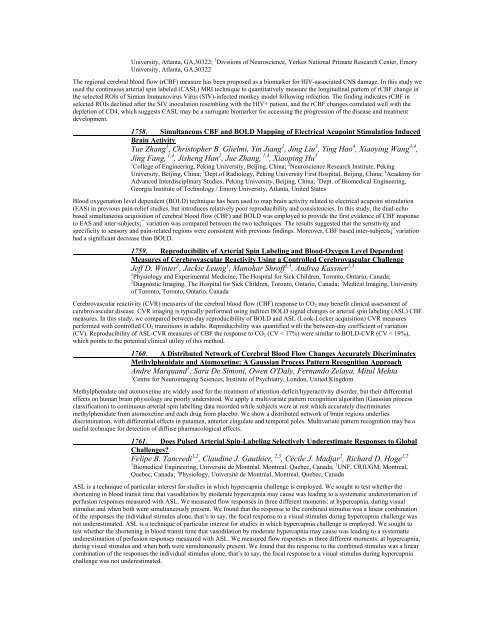Traditional Posters: Diffusion & Perfusion - ismrm
Traditional Posters: Diffusion & Perfusion - ismrm
Traditional Posters: Diffusion & Perfusion - ismrm
You also want an ePaper? Increase the reach of your titles
YUMPU automatically turns print PDFs into web optimized ePapers that Google loves.
University, Atlanta, GA,30322; 3 Divisions of Neuroscience, Yerkes National Primate Research Center, Emory<br />
University, Atlanta, GA,30322<br />
The regional cerebral blood flow (rCBF) measure has been proposed as a biomarker for HIV-associated CNS damage. In this study we<br />
used the continuous arterial spin labeled (CASL) MRI technique to quantitatively measure the longitudinal pattern of rCBF change in<br />
the selected ROIs of Simian Immunovirus Virus (SIV)-infected monkey model following infection. The finding indicates rCBF in<br />
selected ROIs declined after the SIV inoculation resembling with the HIV+ patient, and the rCBF changes correlated well with the<br />
depletion of CD4, which suggests CASL may be a surrogate biomarker for accessing the progression of the disease and treatment<br />
development.<br />
1758. Simultaneous CBF and BOLD Mapping of Electrical Acupoint Stimulation Induced<br />
Brain Activity<br />
Yue Zhang 1 , Christopher B. Glielmi, Yin Jiang 2 , Jing Liu 3 , Ying Hao 4 , Xiaoying Wang 3,4 ,<br />
Jing Fang, 1,4 , Jisheng Han 2 , Jue Zhang, 1,4 , Xiaoping Hu 5<br />
1 College of Engineering, Peking University, Beijing, China; 2 Neuroscience Research Institute, Peking<br />
University, Beijing, China; 3 Dept.of Radiology, Peking University First Hospital, Beijing, China; 4 Academy for<br />
Advanced Interdisciplinary Studies, Peking University, Beijing, China; 5 Dept. of Biomedical Engineering,<br />
Georgia Institute of Technology / Emory University, Atlanta, United States<br />
Blood oxygenation level dependent (BOLD) technique has been used to map brain activity related to electrical acupoint stimulation<br />
(EAS) in previous pain-relief studies, but introduces relatively poor reproducibility and consistencies. In this study, the dual-echo<br />
based simultaneous acquisition of cerebral blood flow (CBF) and BOLD was employed to provide the first evidence of CBF response<br />
to EAS and inter-subjects¡¯ variation was compared between the two techniques. The results suggested that the sensitivity and<br />
specificity to sensory and pain-related regions were consistent with previous findings. Moreover, CBF based inter-subjects¡¯variation<br />
had a significant decrease than BOLD.<br />
1759. Reproducibility of Arterial Spin Labeling and Blood-Oxygen Level Dependent<br />
Measures of Cerebrovascular Reactivity Using a Controlled Cerebrovascular Challenge<br />
Jeff D. Winter 1 , Jackie Leung 1 , Manohar Shroff 2,3 , Andrea Kassner 1,3<br />
1 Physiology and Experimental Medicine, The Hospital for Sick Children, Toronto, Ontario, Canada;<br />
2 Diagnostic Imaging, The Hospital for Sick Children, Toronto, Ontario, Canada; 3 Medical Imaging, University<br />
of Toronto, Toronto, Ontario, Canada<br />
Cerebrovascular reactivity (CVR) measures of the cerebral blood flow (CBF) response to CO 2 may benefit clinical assessment of<br />
cerebrovascular disease. CVR imaging is typically performed using indirect BOLD signal changes or arterial spin labeling (ASL) CBF<br />
measures. In this study, we compared between-day reproducibility of BOLD and ASL (Look-Locker acquisition) CVR measures<br />
performed with controlled CO 2 transitions in adults. Reproducibility was quantified with the between-day coefficient of variation<br />
(CV). Reproducibility of ASL-CVR measures of CBF the response to CO 2 (CV < 17%) were similar to BOLD-CVR (CV < 19%),<br />
which points to the potential clinical utility of this method.<br />
1760. A Distributed Network of Cerebral Blood Flow Changes Accurately Discriminates<br />
Methylphenidate and Atomoxetine: A Gaussian Process Pattern Recognition Approach<br />
Andre Marquand 1 , Sara De Simoni, Owen O'Daly, Fernando Zelaya, Mitul Mehta<br />
1 Centre for Neuroimaging Sciences, Institute of Psychiatry, London, United Kingdom<br />
Methylphenidate and atomoxetine are widely used for the treatment of attention-deficit/hyperactivity disorder, but their differential<br />
effects on human brain physiology are poorly understood. We apply a multivariate pattern recognition algorithm (Gaussian process<br />
classification) to continuous arterial spin labelling data recorded while subjects were at rest which accurately discriminates<br />
methylphenidate from atomoxetine and each drug from placebo. We show a distributed network of brain regions underlies<br />
discrimination, with differential effects in putamen, anterior cingulate and temporal poles. Multivariate pattern recognition may be a<br />
useful technique for detection of diffuse pharmacological effects.<br />
1761. Does Pulsed Arterial Spin-Labeling Selectively Underestimate Responses to Global<br />
Challenges?<br />
Felipe B. Tancredi 1,2 , Claudine J. Gauthier, 2,3 , Cécile J. Madjar 2 , Richard D. Hoge 1,2<br />
1 Biomedical Engineering, Université de Montréal, Montreal, Quebec, Canada; 2 UNF, CRIUGM, Montreal,<br />
Quebec, Canada; 3 Physiology, Université de Montréal, Montreal, Quebec, Canada<br />
ASL is a technique of particular interest for studies in which hypercapnia challenge is employed. We sought to test whether the<br />
shortening in blood transit time that vasodilation by moderate hypercapnia may cause was leading to a systematic underestimation of<br />
perfusion responses measured with ASL. We measured flow responses in three different moments: at hypercapnia, during visual<br />
stimulus and when both were simultaneously present. We found that the response to the combined stimulus was a linear combination<br />
of the responses the individual stimulus alone, that’s to say, the focal response to a visual stimulus during hypercapnia challenge was<br />
not underestimated. ASL is a technique of particular interest for studies in which hypercapnia challenge is employed. We sought to<br />
test whether the shortening in blood transit time that vasodilation by moderate hypercapnia may cause was leading to a systematic<br />
underestimation of perfusion responses measured with ASL. We measured flow responses in three different moments: at hypercapnia,<br />
during visual stimulus and when both were simultaneously present. We found that the response to the combined stimulus was a linear<br />
combination of the responses the individual stimulus alone, that’s to say, the focal response to a visual stimulus during hypercapnia<br />
challenge was not underestimated.















